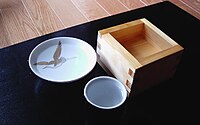
Photo from wikipedia
Rhizoctonia solani is a soil-borne fungus causing sheath blight disease in cereal crops including rice. Genetic resistance to sheath blight disease in cereal crops is not well understood in most… Click to show full abstract
Rhizoctonia solani is a soil-borne fungus causing sheath blight disease in cereal crops including rice. Genetic resistance to sheath blight disease in cereal crops is not well understood in most of the host(s). Aside from this, a comparative study on the different hosts at the biochemical and proteomic level upon R. solani infection was not reported earlier. Here, we performed proteomic based analysis and studied defense pathways among cultivated rice (cv. Pusa Basmati-1), wild rice accession (Oryza grandiglumis), and barley (cv. NDB-1445) after inoculation with R. solani. Increased levels of phenol, peroxidase, and β-1, 3-glucanase were observed in infected tissue as compared to the control in all of the hosts. Wild rice accession O. grandiglumis showed a higher level of biochemical signals than barley cv. NDB 1445 and cultivated rice cv. Pusa Basmati-1. Using two-dimensional polyacrylamide gel electrophoresis (2D-PAGE) and mass spectrometry (MS), differently expressed proteins were also studied in control and after inoculation with R. solani. Wild rice accession O. grandiglumis induced a cysteine protease inhibitor and zinc finger proteins, which have defense functions and resistance against fungal pathogens. On the other hand, barley cv. NDB-1445 and cultivated rice cv. Pusa Basmati-1 mainly induce energy metabolism-related proteins/signals after inoculation with R. solani in comparison to wild rice accession O. grandiglumis. The present comprehensive study of R. solani interaction using three hosts, namely, Pusa Basmati-1 (cultivated rice), O. grandiglumis (wild rice), and NDB-1445 (barley) would interpret wider possibilities in the dissection of the protein(s) induced during the infection process. These proteins may further be correlated to the gene(s) and other related molecular tools that will help for the marker-assisted breeding and/or gene editing for this distressing disease among the major cereal crops.
Journal Title: Bioengineering
Year Published: 2022
Link to full text (if available)
Share on Social Media: Sign Up to like & get
recommendations!